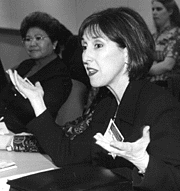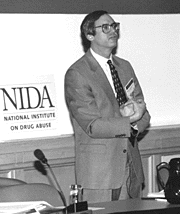Discussions about how to get the message out that drug addiction is a disease, not just a failure of choice, took center stage at this year's NIDA constituent conference. Calls for unity, leadership, and advocacy in this effort echoed throughout most of the conference sessions.
For the fourth year, members of national organizations whose work is tied to drug abuse met to advise the Institute and to provide recommendations for NIDA activities. During the 2-day meeting, NIDA Director Dr. Alan I. Leshner presented a "report card" of activities the Institute has undertaken that respond to recommendations constituents have made at previous conferences (see "NIDA's Report Card",). The conference was held in Lansdowne, Virginia, last December.
 At the conference, constituents provided NIDA staff with feedback on current NIDA activities and made recommendations for future NIDA research and program initiatives.
At the conference, constituents provided NIDA staff with feedback on current NIDA activities and made recommendations for future NIDA research and program initiatives.At the meeting, members of 47 constituent groups (see list) talked with top NIDA program staff about how they could make use of the science that NIDA supports to help the general public, members of the criminal justice system, policymakers, and health care professionals replace long-held impressions of drug addiction as solely a behavioral or social problem. The ultimate goal is to have the scientific facts about drug addiction filter into the consciousness of the Nation so that they become the foundation for drug abuse and addiction prevention, treatment, and policy strategies, said Dr. Leshner. Because the effort is not an easy one, "We need to move together and come together in a far more unified way than we have ever done before," he told the constituents.
Research funded by NIDA has shown clearly that people become addicted to drugs when repeated drug use actually changes the way their brains work. It is at this point that drug abuse becomes a chronic, relapsing illness that is expressed through behavior and occurs in a social context. The fact that so many people in this country have not heard of the scientific basis of drug abuse and addiction makes getting the word out and changing people's attitudes about drug abuse much like "pushing the elephant up the hill,"said Dr. Leshner. That is why constituents and NIDA staff at the conference, who are the leaders in the drug abuse community, need to talk about how to work together to educate people nationwide about the true scientific nature of drug abuse and addiction, he said.
 During NIDA's constituent conference, Paul Samuels, director of the Legal Action Center, urged constituent groups to join forces to educate people about the importance of drug abuse research, treatment, and prevention.
During NIDA's constituent conference, Paul Samuels, director of the Legal Action Center, urged constituent groups to join forces to educate people about the importance of drug abuse research, treatment, and prevention.Working together is central to success, noted two NIDA constituents, who spoke about recent efforts to form alliances to inform others about drug abuse and addiction. To educate professionals such as lawyers and doctors about drug abuse as a public health problem, the American Bar Association (ABA) and the American Medical Association established the National Substance Abuse Coalition, which is based in Washington, D.C. The mission of the organization, said Gloria Danziger, who is coordinating the coalition's activities, is to help professionals view drug abuse as a public health problem and to integrate this new understanding into their work. The ultimate goal: having members who are trained to recognize drug abuse and to ask all their patients or clients about drug and alcohol abuse, she said. Danziger is staff director of the ABA's Standing Committee on Substance Abuse in Washington, D.C.
Working together to reach as many people as possible is key to educating the public about the importance of drug abuse research, prevention, and treatment, stressed Paul Samuels, who has worked with other national groups to set up an alliance for that purpose. One of the priorities of the alliance will be to educate people, such as journalists, who can serve as advocates for the science of addiction, he said. Members of the alliance need to present clear positions about drug abuse treatment and prevention, he told the constituents. "We need to educate people to see drug addiction in a different way," as a preventable, treatable illness, said Samuels, director of the Legal Action Center. With offices in Washington, D.C., and New York City, the center serves as legal representative to individuals with past or current drug and alcohol problems or HIV/AIDS.
Right now the climate for public education is good because the media are providing a lot of coverage of the biological aspects of drug abuse, said Dr. Leshner. He cited as an example the recent five-part public television series "Moyers on Addiction: Close to Home," to which NIDA contributed. NIDA constituent groups need to work together to promote such media productions, which draw attention to this issue, he said.
In the meantime, NIDA has been collaborating with other groups to make sure that the results of its research are useful and used, with an ultimate goal of educating the public about drug abuse and addiction, said Dr. Leshner. For example, NIDA teamed up with the Entertainment Industries Council, Inc., to recognize industry efforts to depict accurately drug abuse and related violence in films and on television. Since then, NIDA has been fielding calls from television show producers asking how to portray drug-related situations realistically. These and other efforts, such as the Mind Over Matter package of drug abuse education materials that NIDA developed for fifth through ninth graders, are intended to make science interesting and to help change people's ideas about addiction and drug abuse.
The Institute has developed a wide variety of easy-to-understand resources, such as publications, reports, information fact sheets, videos, and the Home page, to name just a few, that translate research-based information for the field. These are readily available, and NIDA continues to encourage everyone, not just drug abuse constituent groups, to make use of them to educate others about the scientific basis of drug abuse and addiction.
